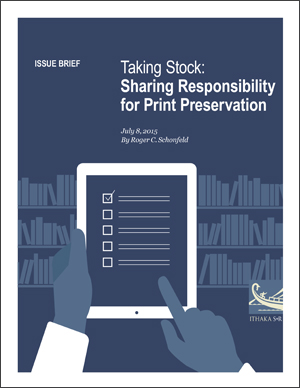Taking Stock: Sharing Responsibility for Print Preservation
How do we ensure the long-term preservation of our print heritage even as our collections move more fully online?
In “Taking Stock: Sharing Responsibility for Print Preservation,” Roger Schonfeld surveys the progress our community has made in the past decade, but warns against the conflation of collaborative print management and improved access to collections with preservation.
While “we may have developed a strong network for managing down print, Schonfeld argues, “whether that will yield long-term preservation goals is quite another matter.”
This issue brief was first presented at Preserving America’s Print Resources II: A North American Summit in Berkeley, California, on June 25, 2015. We look forward to continuing the conversation through the comments below.
Interested? Download “Taking Stock: Sharing Responsibility for Print Preservation.”

Comments
Comments, “Taking Stock”, ITHAKA S+R, July 8, 2015, from Gary Frost 1.Can the premise of supersession of formats be more carefully examined? Can we really assume that stored print collections will depreciate and decline in functionality? Perhaps new functionalities of stored print in context of their screen use will emerge. Such functionalities could emerge from certification, authentication and systems redundancy roles as well as from roles currently unforeseen. Audio genres exhibit continuing print format interdependencies. 2.Redundant print retention is considered adverse and unsustainable. Well and good. However, it can be recalled that local redundancy was a systems feature of paper collections. It buffered the operability of an analogue format database of physical collections. 3.As we adapt the usefulness of print collections to screen access routines we should not necessarily assume outcome from extinguishing physical print circulations. In addition to the inevitable sequester of high-density storage, we may encounter a strange new counter trend as instructional and epistemic attention turns to material studies of book transmission. Study of physical copies as a medium of its interventions of production, marketing, ownership, library and conservation re-fabrication is an example. 4.Is it strange to cite “space” as a strategic library goal? This sounds like an agenda from a facility services group.